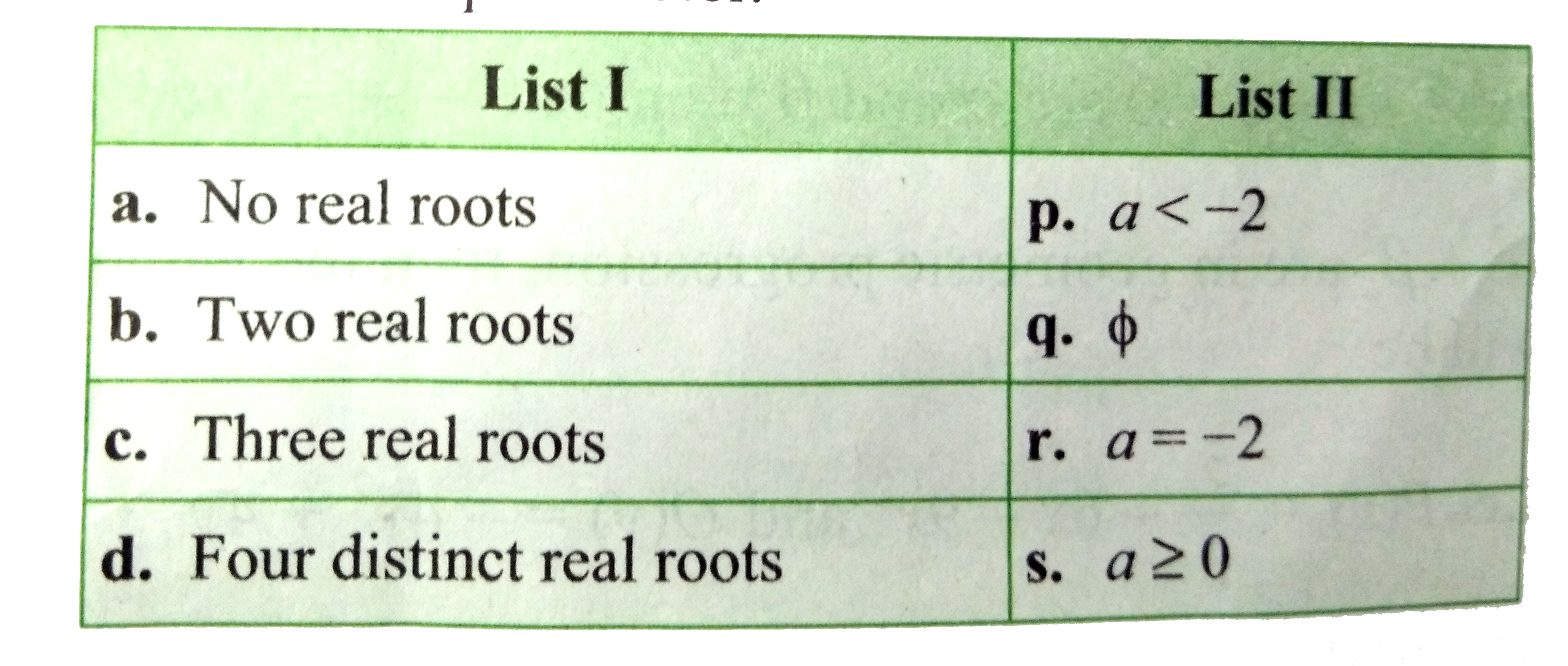Let a,b,c∈Q+ satisfying a>b>⋅ Which of the following statements (s) hold true of the quadratic polynomial f(x)=(a+b−2c)x2+(b+c−2a)x+(c+a−2b)? The mouth of the parabola y=f(x) opens upwards Both roots of the equation f(x)=0 are rational The x-coordinate of vertex of the graph is positive The product of the roots is always negativeSolution in Bengali
The mouth of the parabola f(x) = 0 opens upwards
Both roots of the equation f(x) = 0 are rational
The x-coordinate of vertex of the graph is positive
The product of the roots is always negative .
The correct Answer is:1,2,3,
f(x)=Ax2+Bx+C
A=a+b−2c=(a−c)+(b−c)>0
⇒A>0
Hence, the graph is concave upwards. Also, x = 1 is obvious
Solution, therefore .both roots are rational
b+c−2a=b−a−ve+c−a−ve<0
⇒B<0
∴−B2A>0
Hence , abscissa of the vertex is positive . Option (d) need not be
correct as with a = 5 ,b = 4 , c = 2 , P< 0 and with a = 6 , b = 3
c = 2, P > 0 .
Topper's Solved these Questions
- THEORY OF EQUATIONSBOOK - CENGAGE PUBLICATIONCHAPTER - THEORY OF EQUATIONSEXERCISE - Linked Comprechension Type
37 Videos
- THEORY OF EQUATIONSBOOK - CENGAGE PUBLICATIONCHAPTER - THEORY OF EQUATIONSEXERCISE - MATRIX MATCH TYPE
6 Videos
- THEORY OF EQUATIONSBOOK - CENGAGE PUBLICATIONCHAPTER - THEORY OF EQUATIONSEXERCISE - Single Correct Answer Type : Exercise
89 Videos
- STRAIGHT LINESBOOK - CENGAGE PUBLICATIONCHAPTER - STRAIGHT LINESEXERCISE - ARCHIVES (NUMERICAL VALUE TYPE)
1 Videos
- THREE DIMENSIONAL GEOMETRYBOOK - CENGAGE PUBLICATIONCHAPTER - THREE DIMENSIONAL GEOMETRYEXERCISE - All Questions
291 Videos
Similar Questions
Consider an unknow polynomial which divided by (x−3) and (x−4) leaves remainder 2 and 1, respectively. Let R(x) be the remainder when this polynomial is divided by (x−3)(x−4).
If equations R(x)=x2+ax+1 has two distint real roots, then exhaustive values of a are.
View SolutionMatch the following for the equation x2+a|x|+1=0 where, a is a parameter.

View SolutionThe value of expression x4−8x3+18x2−8x+2 when x=2+√3
View SolutionFor a point P in the plane, let d1(P)andd2(P) be the distances of the point P from the lines x−y=0andx+y=0 respectively. The area of the region R consisting of all points P lying in the first quadrant of the plane and satisfying 2≤d1(P)+d2(P)≤4, is
View SolutionFind the angle between the line whose direction cosines are given by l+m+n=0andl2+m2−n2=0.
View SolutionLet a,b,c∈Q+ satisfying a>b>⋅ Which of the following statements (s) hold true of the quadratic polynomial f(x)=(a+b−2c)x2+(b+c−2a)x+(c+a−2b)? The mouth of the parabola y=f(x) opens upwards Both roots of the equation f(x)=0 are rational The x-coordinate of vertex of the graph is positive The product of the roots is always negative
View SolutionThe roots of the quadratic equation (a+b−2c)x2+(2a−b−c)x+(a−2b+c)=0 are
View SolutionIf a,b,c in Q, then roots of the equation (b+c-2a)x^(2)+(c+a-2b)x+(a+b-2c)=0 are
View SolutionIf a,b,c are positive rational numbers such that a>b>c and the quadratic eqution (a+b−2c)x2+(b+c−2a)x+(c+a−2b)=0 has a root of the interval (-1,0) then (A) c+a<2b (B) the roots of the equation are rational (C) the roots of are imaginary (D) none of these
View SolutionIf a ,b ,c are non zero rational no then prove roots of equation (abc2)x2+3a2cx+b2cx−6a2−ab+2b2=0 are rational.
View SolutionLet a,b,c∈Q+ satisfying a>b>c. Which of the following statement(s) hold true of the quadratic polynomial f(x)=(a+b−2c)x2+(b+c−2a)x+(c+a−2b)? a. The mouth of the parabola y=f(x) opens upwards b. Both roots of the equation f(x)=0 are rational c. The x-coordinate of vertex of the graph is positive d. The product of the roots is always negative
View SolutionLet a,b,c∈Q+ satisfying a>b>⋅ Which of the following statements (s) hold true of the quadratic polynomial f(x)=(a+b−2c)x2+(b+c−2a)x+(c+a−2b)? The mouth of the parabola y=f(x) opens upwards Both roots of the equation f(x)=0 are rational The x-coordinate of vertex of the graph is positive The product of the roots is always negative
View SolutionIf a,b,c are real, then both the roots of the equation (x-b)(x-c)+(x-c)(x-a)+(x-a)(x-b)=0 are always (A) positive (B) negative (C) real (D) imaginary.
View SolutionThe roots of the quadratic equation (a+b−2c)x2+(2a−b−c)x+(a−2b+c)=0 are
View SolutionIf secθ+tanθ=1, then root of the equation (a−2b+c)x2+(b−2c+a)x+(c−2a+b)=0 is:
View SolutionIf a ,b ,c are non zero rational no then prove roots of equation (abc2)x2+3a2cx+b2cx−6a2−ab+2b2=0 are rational.
View Solution
